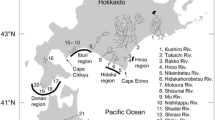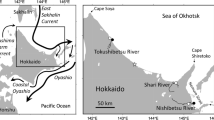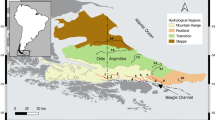Abstract
We examined the sea-entry conditions (i.e., timing and body size) of juvenile chum salmon that improve their survival during their coastal residency. On 25 June 2013, we sampled 365 juvenile chum salmon [57.5–98.6 mm fork length (FL)] off Konbumori, eastern Hokkaido, ⁓ 20 km east of the Kushiro River mouth, which originated from a hatchery in the Kushiro River. Sea-entry conditions of these Konbumori juveniles back-calculated using otolith daily increment analysis were compared with data from 373 juveniles released from the same hatchery that were captured at the mouth of Kushiro River (i.e., just before sea entry) from April to July 2013. Most of the Konbumori fish were estimated to have entered the sea from 25 May to 5 June, when coastal surface temperatures constantly exceeded 5 °C, which is considered favorable for juveniles. The estimated FLs at sea entry of the Konbumori fish were larger than FLs of fish sampled at the river mouth during a comparable period, which suggests that size-selective mortality existed. Back-calculated post-sea-entry growth rates of fish with larger FL at sea entry, particularly those with FL > 65 mm, tended to be high enough for survival among the Konbumori fish. Assuming growth-dependent mortality, this case study suggests that the release of larger-sized juveniles under favorable coastal temperature conditions improves their survival.






Similar content being viewed by others
References
Armstrong JD, Stewart DC (1997) The effects of initial length and body curvature on shrinkage of juvenile Atlantic salmon during freezing. J Fish Biol 50:903–905
Bartoń K (2018) MuMIn: multi-model inference. In: R package version 1.42.1. The Comprehensive R Archive Network (CRAN). R Foundation for Statistical Computing, Vienna. https://CRAN.R-project.org/package=MuMIn. Accessed 28 Jan 2020
Bax NJ (1983) Early marine mortality of marked juvenile chum salmon (Oncorhynchus keta) released into Hood Canal, Puget Sound, Washington, in 1980. Can J Fish Aquat Sci 40:426–435
Beacham TD, Araujo HA, Tucker S, Trudel M (2018) Validity of inferring size-selective mortality and a critical size limit in Pacific salmon from scale circulus spacing. PLoS One 13:e0199418
Beamish RJ (ed) (2018) Ocean ecology of Pacific salmon and trout. American Fisheries Society, Bethesda
Beamish RJ, Thomson BL, McFarlane GA (1992) Spiny dogfish predation on Chinook and coho salmon and the potential effects on hatchery-produced salmon. Trans Am Fish Soc 121:444–455
Chistyakova AI, Bugaev AV (2016) An assessment of the origin and migration routes of juvenile hatchery pink and chum salmon in the basin of the Okhotsk Sea in 2011–2014. Res Aquat Biol Resour Kamchatka Northwest Part Pac Ocean 40:5–23 (In Russian with English abstract)
Claiborne AM, Miller JA, Weitkamp LA, Teel DJ, Emmett RL (2014) Evidence for selective mortality in marine environments: the role of fish migration size, timing, and production type. Mar Ecol Prog Ser 515:187–202
Fukuwaka M, Suzuki T (2002) Early sea mortality of mark-recaptured juvenile chum salmon in open coastal waters. J Fish Biol 60:3–12
Healey MC (1982) Timing and relative intensity of size-selective mortality of juvenile chum salmon (Oncorhynchus keta) during early sea life. Can J Fish Aquat Sci 39:952–957
Honda K, Kawakami T, Suzuki K, Watanabe K, Saito T (2017) Growth rate characteristics of juvenile chum salmon Oncorhynchus keta originating from the Pacific coast of Japan and reaching Konbumori, eastern Hokkaido. Fish Sci 83:987–996
Honda K, Kawakami T, Saito T, Urawa S (2019) First report of growth rate of juvenile chum salmon Oncorhynchus keta captured in the Sea of Okhotsk offshore. Ichthyol Res 66:155–159
Irie T (1990) Ecological studies on the migration of juvenile chum salmon, Oncorhynchus keta, during early ocean life. Bull Seikai Natl Fish Res Inst 68:1–142 (in Japanese with English abstract)
Kaeriyama M (1986) Ecological study on early life of the chum salmon, Oncorhynchus keta (Walbaum). Sci Rep Hokkaido Salmon Hatch 40:31–92 (In Japanese with English abstract)
Kasugai K (2013) The effects of different methods of preservation and fixation in formalin and ethanol upon body size of juvenile chum salmon. Sci Rep Hokkaido Fish Hatch 84:11–19 (In Japanese with English abstract)
Kitada S (2014) Japanese chum salmon stock enhancement: current perspective and future challenges. Fish Sci 80:237–249
Kobayashi T (1977) Ecology of juvenile salmon in early marine life stage. Bull Jpn Soc Fish Oceanogr 31:39–44 (In Japanese)
Mayama H, Ishida Y (2003) Japanese studies on the early ocean life of juvenile salmon. N Pac Anadr Fish Comm Bull 3:14–67
Mayama H, Kato M, Seki J, Shimizu I (1982) Studies on the chum salmon released in the Ishikari River system. I. On the seaward migration and inshore distribution of liberated fry in 1979. Sci Rep Hokkaido Salmon Hatch 36:1–17 (In Japanese with English abstract)
Miyakoshi Y (2018) Current status of chum salmon stocks in Hokkaido. Aquabiology 40:330–334 (In Japanese with English abstract)
Miyakoshi Y, Urabe H, Saneyoshi H, Aoyama T, Sakamoto H, Ando D, Kasugai K, Mishima Y, Takada M, Nagata M (2012a) The occurrence and run timing of naturally spawning chum salmon in northern Japan. Environ Biol Fishes 94:197–206
Miyakoshi Y, Ando D, Fujiwara M, Hayano H, Nagata M (2012b) Downstream migration of chum salmon released in the Abashiri River. Sci Rep Hokkaido Fish Hatch 82:19–26 (In Japanese with English abstract)
Miyakoshi Y, Nagata M, Kitada S, Kaeriyama M (2013) Historical and current hatchery programs and management of chum salmon in Hokkaido, northern Japan. Rev Fish Sci 21:469–479
Morita K, Nakashima A (2015) Temperature seasonality during fry out-migration influences the survival of hatchery-reared chum salmon Oncorhynchus keta. J Fish Biol 87:1111–1117
Morita K, Saito T, Miyakoshi Y, Fukuwaka M, Nagasawa T, Kaeriyama M (2006) A review of Pacific salmon hatchery programmes on Hokkaido Island, Japan. ICES J Mar Sci 63:1353–1363
Morita K, Takahashi S, Ohkuma K, Nagasawa T (2013) Estimation of the proportion of wild chum salmon Oncorhynchus keta in Japanese hatchery rivers. Nippon Suisan Gakkaishi 79:206–213 (in Japanese with English abstract)
Morita K, Fukuzawa H, Suzuki K (2019) Comparison of fry-to-adult survival rates between wild and hatchery chum salmon in the Chitose River, Hokkaido, Japan. J Fish Tech 11:9–14 (In Japanese with English abstract)
Okado J, Koshino Y, Kudo H, Watanuki Y (2020) Consumption of juvenile chum salmon by a seabird species during early sea life. Fish Res 222:105415
R Core Team (2018) R: a language and environment for statistical computing. R Foundation for Statistical Computing, Vienna. https://www.r-project.org/. Accessed 28 Jan 2020
Saito T, Fukuwaka M (2018) Status of Pacific salmon production in the North Pacific Ocean. Aquabiology 40:319–329 (In Japanese with English abstract)
Saito T, Miyakoshi Y (2018) Current status of chum and pink salmon: what is reducing adult returns in Japan? N Pac Anadr Fish Comm Tech Rep 11:8–9
Saito T, Nagasawa K (2009) Regional synchrony in return rates of chum salmon (Oncorhynchus keta) in Japan in relation to coastal temperature and size at release. Fish Res 95:14–27
Saito T, Kaga T, Seki J, Otake T (2007) Otolith microstructure of chum salmon Oncorhynchus keta: formation of sea entry check and daily deposition of otolith increments in seawater conditions. Fish Sci 73:27–37
Saito T, Shimizu I, Seki J, Nagasawa K (2009) Relationship between zooplankton abundance and the early marine life history of juvenile chum salmon Oncorhynchus keta in eastern Hokkaido, Japan. Fish Sci 75:303–316
Salo EO (1991) Life history of chum salmon (Oncorhynchus keta). In: Groot C, Margolis L (eds) Pacific salmon life histories. UBC, Vancouver, pp 233–309
Seki J (2005) Study of characteristics of feeding habitats of juvenile chum salmon and their food environment in the Pacific coastal waters, central part of Hokkaido. Bull Natl Salmon Resour Center 7:1–104 (In Japanese with English abstract)
Seki J (2013) Development of hatchery techniques for releasing juvenile chum salmon in Japan. J Fish Technol 6:69–82 (In Japanese with English abstract)
Seki J, Shimizu I (1996) Effect time of larval release on return rate in chum salmon (Oncorhynchus keta) in the Hiroo River, Hokkaido, Japan. Bull Jpn Soc Fish Oceanogr 60:339–347 (In Japanese with English abstract)
Sogard SM (1997) Size-selective mortality in the juvenile stage of teleost fishes: a review. Bull Mar Sci 60:1129–1157
Takahashi F (2010) Findings obtained from otolith-thermal marked chum salmon. Part 2: comparison of release timing and size. FRA Salmon Res Rep 4:12–14 (In Japanese)
Tomaro LM, Teel DJ, Peterson WT, Miller JA (2012) When is bigger better? Early marine residence of middle and upper Columbia River spring Chinook salmon. Mar Ecol Prog Ser 452:237–252
Torao M, Takeuchi K, Sasaki Y, Kasugai K, Murakami Y, Nagata M (2010) Seasonal timing of downstream migration and migrating speed of the hatchery and wild pink salmon, Oncorhynchus gorbuscha fry in the Tohoro River, eastern Hokkaido, Japan. Sci Rep Hokkaido Fish Hatch 64:7–15 (In Japanese with English abstract)
Tucker S, Hipfner JM, Trudel M (2016) Size- and condition-dependent predation: a seabird disproportionately targets substandard individual juvenile salmon. Ecology 97:461–471
Urawa S, Hagen P, Meerburg D, Rogatnykh A, Volk E (2001) Compiling and coordinating salmon otolith marks in the North Pacific. N Pac Anadr Fish Comm Tech Rep 3:13–15
Urawa S, Beacham TD, Fukuwaka M, Kaeriyama M (2018) Ocean ecology of chum salmon. In: Beamish RJ (ed) Ocean ecology of Pacific salmon and trout. American Fisheries Society, Bethesda, pp 161–317
Vega SL, Sutton TM, Murphy JM (2017) Marine-entry timing and growth rates of juvenile chum Salmon in Alaskan waters of the Chukchi and northern Bering seas. Deep Sea Res Part II 135:137–144
Ward AJW, Webster MM, Hart PJB (2006) Intraspecific food competition in fishes. Fish Fish 7:231–261
Wertheimer AC, Thrower EP (2007) Mortality rates of chum salmon during their initial marine residency. In: Grimes PE, et al. (eds) Ecology of juvenile salmon in the Northeast Pacific Ocean: regional comparisons. American Fisheries Society Symposium, vol. 57. American Fisheries Society, Bethesda, pp 233–247
Wood S (2019) mgcv: mixed GAM computation vehicle with automatic smoothness estimation. In R package version 1.8-28. The Comprehensive R Archive Network (CRAN). R Foundation for Statistical Computing, Vienna https://cran.r-project.org/web/packages/mgcv/mgcv.pdf. Accessed 28 Jan 2020
Woodson LE, Wells BK, Weber PK, Macfarlane RB, Whitman GE, Johnson RC (2013) Size, growth, and origin-dependent mortality of juvenile Chinook salmon Oncorhynchus tshawytscha during early ocean residence. Mar Ecol Prog Ser 487:163–175
Yatsu A, Kaeriyama M (2005) Linkages between coastal and open-ocean habitats and dynamics of Japanese stocks of chum salmon and Japanese sardine. Deep Sea Res Part II 52:727–737
Acknowledgments
We thank staff of the Japan Fisheries Research and Education Agency, and in particular S. Toda and F. Ito, for their cooperation in collecting field data over the successive years of the study. We also thank T. Kitagawa, T. Kawakami, and Y. Kusaba at the University of Tokyo for their support and help with the analysis using the electron probe micro-analyzer. This study was supported by the Fisheries Agency of Japan as part of the Salmon Resources along the Pacific Coast of Japan Restoration Project, and by the Cooperative Program of Atmosphere and Ocean Research Institute, The University of Tokyo (no. 145, 2018).
Author information
Authors and Affiliations
Corresponding author
Additional information
Publisher's Note
Springer Nature remains neutral with regard to jurisdictional claims in published maps and institutional affiliations.
Electronic supplementary material
Below is the link to the electronic supplementary material.
Rights and permissions
About this article
Cite this article
Honda, K., Shirai, K., Komatsu, S. et al. Sea-entry conditions of juvenile chum salmon Oncorhynchus keta that improve post-sea-entry survival: a case study of the 2012 brood-year stock released from the Kushiro River, eastern Hokkaido, Japan. Fish Sci 86, 783–792 (2020). https://doi.org/10.1007/s12562-020-01442-0
Received:
Accepted:
Published:
Issue Date:
DOI: https://doi.org/10.1007/s12562-020-01442-0




